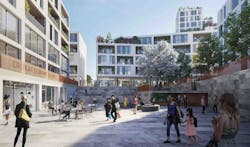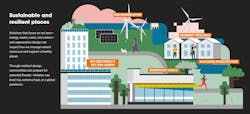5 approaches to a net zero strategy that communities can start right now
Thousands of communities have committed to becoming net zero in the coming decades. Whether your community has started on a plan or is still considering net zero, now is the time for all of us to start seriously addressing climate change. That means building the right infrastructure for cheaper energy, cleaner air and water, and a stronger economy.
Everyone—government, industry, nonprofits, citizens—has a part to play in mobilizing our technology, regulations, finance, and industry for decarbonization. There is no one-size-fits-all approach to net zero. However, here are five factors for policymakers, planners, and designers that are essential for making the great transition.
1. Electrifying energy to net zero and beyond
Net zero requires rethinking infrastructure for massive electrification. Imagine the journey as a waterfall, where we start with the emissions from a conventional district and apply measures until the project reaches or surpasses net zero. The easiest wins (also known as lowest marginal cost of abatement) are in walkable land use and connectivity, compact energy-efficient buildings, and renewable energy. As we move up the waterfall toward the top, the goal is to electrify all energy use and supply clean power.
To make this feasible, communities need to adopt microgrids, district heating and cooling, and efficient waste and wastewater processing (see below). As a last resort—or as a bridge in the roadmap to net zero—communities can offset emissions with offsite investments that create a positive climate impact (e.g., a solar farm) or the purchase of emission reduction credits.
2. Establishing net zero zoning and building codes
Thousands of regulations stand in the way of rolling out climate solutions quickly and cheaply. Fighting climate change involves using every tool at a local government’s disposal. That includes rewriting zoning and building codes that were designed for a fossil fuel economy.
Zoning can incentivize net zero buildings for new and redevelopment projects. A net zero building code creates minimum standards for the energy efficiency and renewable energy content of new buildings. A renewable energy standard requires that a certain percentage of a community’s energy come from renewable sources and requires that all new buildings meet a level of energy generation.
Zoning for net zero also means removing any obstacles to broadly defined clean infrastructure. That includes compact homes, walkable mixed-use neighborhoods, electric charging stations, solar panels, and microgrids.
3. Creating a net positive return on investment
Starting today, every big-ticket investment in your community must replace fossil fuel use with clean energy. We must lead by example.
While decarbonizing technologies have slightly higher up-front capital costs, in real terms you cannot afford not to decarbonize. By integrating the value of future risks, including soaring fossil fuel prices, as well as the funding and subsidies available for clean infrastructure, your net zero strategy will have a net positive return on investment.
Making the right infrastructure upgrades today require financial resources, such as electric vehicle charging stations and green buildings. Tax breaks or rebates are needed to enable and encourage net zero investments. These investments are also a hedge against increasing regulatory pressure to decarbonize.
In the long run, it’s more efficient to make investments up front. Waiting and reacting with a piecemeal approach to more stringent regulations is a backward method.
4. Expanding net zero mobility
Urban planning and design are part of the energy transition. Land use has a significant impact on how we get around our cities. In descending order of priority, ensure that all local decisions support: a compact, walkable urban form; expanded access to public transit; and electric vehicles.
The 15-minute neighborhood creates opportunities for people to live, work, and play without emissions. And it improves health outcomes. Local governments can connect neighborhoods with expanded and electrified public transit. For those who enjoy a personal car as part of their lifestyle, electric vehicles also need to be part of the transition.
5. Creating a circular economy
Getting to net zero emissions includes impacts from solid waste and wastewater. In contrast to a linear process, the circular economy returns products from waste into the economic stream.
An integrated waste-management strategy includes a variety of ways to reduce waste, recover materials, and recycle products. At the community scale, you can rethink your investments into wastewater treatment, solid waste collection and processing, and green procurement. Also promote sharing, repairing, and reusing products with a community center.
Reaching net zero for your community
These approaches need to be paired with an action plan and a task force, as well as coordinated with various levels of government. Community-based changes like retraining the workforce, supporting natural systems, and promoting local food production will add up to reach net zero overall.
It starts with a plan and prioritizing the necessary infrastructure investments and policies. With that in place, your community can be part of the solution just by going about its daily routine.

